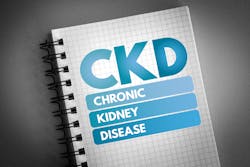Intermountain Focuses on Early Identification of Kidney Disease Patients
For the past year, Intermountain Healthcare System Kidney Services has been analyzing data to better identify patients and prioritize populations with chronic conditions for early outreach and care coordination. The goal is to reduce hospitalizations and prevent unnecessary morbidity and mortality by identifying and engaging patients in early stages of chronic kidney disease (CKD).
Ray Morales, executive operations director at Intermountain Healthcare System Kidney Services in Salt Lake City, said the journey began several years ago. About five years ago Intermountain was trying to decide whether or not it would participate in the Centers for Medicare & Medicaid Services accountable care program for kidney disease called End Stage Renal Disease (ESRD) Seamless Care Organizations (ESCOs).
“We decided to do a root cause analysis and an evaluation of that opportunity,” Morales said. “We mapped out the patient’s journey across our system. Fortunately for us, as an integrated system we have pretty good visibility into the different touch points our patients have. What we identified was that there was a more significant opportunity to engage these patients earlier in the disease process as opposed to building a larger net at the end of the stream to capture these patients once they fall into dialysis.”
Like other health systems, Intermountain has found that many CKD patients are unaware they have the condition until they end up in the hospital. Citing numbers from the Centers for Disease Control, Morales said one in seven adults has chronic kidney disease and of those, nine in 10 are unaware. “In health systems like ours, close to 70 percent of these patients end up in the hospital in an emergent state finding out for the first time that they have the disease,” he said. “So that was one hot point we identified. The other critical part we identified early on is that dialysis is expensive and you definitely want to do everything you can to control the cost and improve the outcomes patients have when on dialysis, but the real opportunity to control costs actually resides in managing their comorbidities. For us, close to 70 percent of the cost of care for an ESRD patient actually resides in their comorbidities like hypertension and diabetes. That provides an opportunity for a system like ours to be able to engage patients early on and control that cost before it gets to the later stages of the disease.”
Intermountain has a partnership with an Israel-based company called MDClone, which has a data “Sandbox” that allows Intermountain to look at the patients’ complete medical histories from start to finish in one place — to understand critical decision points in a patient’s care. MDClone worked with clinical and operational leaders in Kidney Services to deploy algorithms that accurately identify CKD patients by stage, presence of acute kidney injury (AKI) and stratified these patients by gaps in care and time from last encounter.
Instead of joining CMS’ ESCO program, Intermountain chose to work with MDClone because they saw a greater opportunity to control cost and outcomes and experience for patients by focusing resources further upstream.
In July 2020 MDClone announced the creation of a Global Network of health systems that will use its platform, installed across the Global Network sites, to develop solutions and explore ideas together to improve patient health. Among the health systems involved are Intermountain, Jefferson Health, Washington University in St Louis, Regenstrief Institute, Jewish General Hospital and the Ottawa Hospital in Canada, and Sheba Medical Center in Israel.
Starting a year ago, Intermountain set up a small cadre of nephrologists and advanced practice providers such as nurse practitioners. A kidney clinic on the main hospital campus services a catchment area of the Salt Lake Valley. They have three nephrologists, six APPs, and five kidney care nurse navigators on the team. “We focus on leveraging technology and providing these services more conveniently and at lower cost for patients,” Morales said. “Care is completely tele-enabled, which has proven to be a very valuable thing with COVID. We can continue to see and manage patients virtually without requiring them to come into the office.”
Morales said that MDClone was able to build and refine real-time data sets based on comorbidity clusters, lab trajectories, CPT codes, ICD-10 codes, claims data, and pathology reports. “That allowed us to be able to look at the patient holistically,” he explained, “and then begin to put those patients into cohorts, risk-score them, and prioritize them. We have gained insights into those individuals who meet the criteria for needing to see a nephrologist but haven’t yet seen one. That is probably the most critical point in this pathway we have identified, and that we have the greatest opportunity to engage and to work proactively.”
Unfortunately, Morales added, because there is such a large group of patients who meet this criteria, their primary focus today is managing those patients with more advanced kidney disease. “We are just beginning to look at those earlier stage patients to begin to engage earlier on and look at collaborations with cardiology and endocrinology to help co-manage their care and put them on the right critical care pathways.”
The nurse navigators have backgrounds in dialysis and are familiar with the care pathway. They use a customer relationship management software tool called SymphonyRM to look at patients longitudinally and ensure patients have disease-specific education and coordination. Within the tool, navigators can identify next best actions and opportunities to engage patients if they missed an appointment. “It hardwires the coordination pathways, and includes real-time care management so the navigators can engage consistently,” Morales said.
Morales said that in the first year, Intermountain has identified close to 2,000 patients in its catchment area, and another 1,000 in its larger system that it plans to engage as the system matures.
“One of our goals was over seven years to get 80 percent of our patients on home dialysis,” he explained. Intermountain had been aligning with national trends of only 10 to 12 percent on home dialysis. “The majority end up in in-center setting largely because they are not being engaged early on in the disease. They find out they have CKD in the hospital and have more limited options then. So far, of the patients we have engaged, we have been able to get over 50 percent on home therapy. There are better outcomes and higher satisfaction there. We can provide the services at lower cost as well. With our SelectHealth insurance product that is an important thing for us. As we look at patients we are engaging with, we are focused on the ones we hold risk on. We can control that per-member per-month expense for those that do need dialysis.”
Intermountain is also focused on reducing hospitalizations for this population. Their target was a 50 percent reduction over seven years. Their CKD and ESRD patients historically average about two hospitalizations per year. “We have been able see only 14 percent of the patients in our program have a hospitalization this past year. It represents phenomenal work on the part of our providers and care navigators. When we look at the data MDClone pulls, these patients have about eight interactions per year, which is much higher than you would see historically. We found that the more frequent visits they have, wherever in the system — primary care or another specialist — they tended to have fewer hospitalizations. We are seeing a result of that as we are getting their care coordinated, and connected with the right providers at the right time.”
Next steps include expanding the work on comorbidities. “We are doing work with our cardiology program and our endocrinology program within Intermountain and MDClone is at the table,” Morales said. “We want to engage patients even earlier on and have an even more cohesive way of managing them. We want to identify these earlier stage CKD patients and engage them. There are many things we can do once we have a better hold on the later stage patients. We can move upstream to slow the progression of the disease further.”
Morales said Intermountain is watching regulatory action in Washington, D.C., to see how it aligns with the work they are doing. An executive order signed last year has aspirational goals of getting 80 percent of patients on home dialysis and doubling the number of transplants. Also in January 2021, new rules allow dialysis patients to switch from Medicare fee-for-service to Medicare Advantage. “That is an important thing to keep in mind, as we look forward to controlling the cost and managing these patients appropriately,” Morales said. “Our risk for these patients is only going to grow as some of these policies are put into place.”


